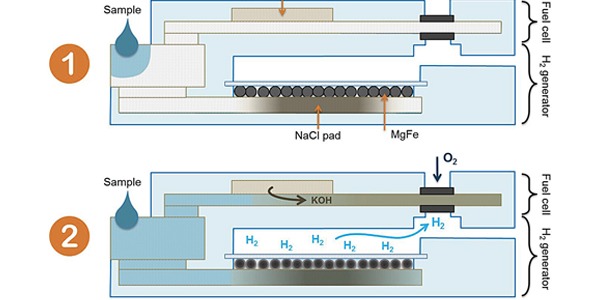Image: Cross-section diagram of paper-based hydrogen fuel cell and stages of operation.
Abstract
Highlights
- A paper-based hydrogen fuel cell operates by capillarity and harvesting hydrogen.
- Takes H2 by-product from exothermic reaction used in point-of-care diagnostics.
- Activates upon the addition of a liquid in a paper inlet pad.
- The paper-based fuel cell produces more than 25 mW in a miniaturized design.
- This approach can be used to power functionalities required for advanced bioassays.
This work demonstrates a stand-alone power source that integrates a paper-based hydrogen fuel cell with a customized chemical heater that produces hydrogen in-situ upon the addition of a liquid. The presented approach operates by capillary action and takes advantage of the hydrogen released as a by-product of an exothermic reaction used in point-of-care diagnostics. The paper-based fuel cell produces a maximum power of 25.8 mW (103.2 mW cm?2), which is suitable for powering a diversity of electrical devices such as commercially available digital pregnancy tests and glucometers. While device shape and dimensions can be customized, here it is shown that the fuel cell can be designed in a compact form factor and footprint comparable to a lateral flow test while providing a remarkable power output. This approach holds great promise for powering portable diagnostics, as the generated electric power could enable device functionalities required for advanced assays, such as device timing, actuation, and signal quantification. Part of the same liquid sample that is to be analyzed (urine, saliva, water, etc) could be used to trigger the hydrogen generation and start the fuel cell operation.


